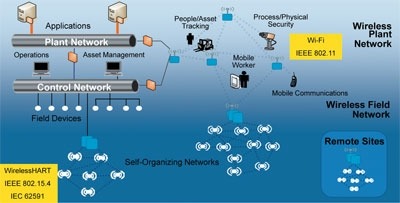Waiting for a single wireless standard
17 Aug 2012

?Imagine you have just powered up a brand new smartphone, say the popular Samsung Galaxy, only to find out that you cannot use it to contact your friends or anyone else who own an iPhone.
This pretend scenario was presented by Dr Alexander Piciorgros, a senior process engineering & innovation manager at chemicals and polymers major Lanxess during the recent Achema 2012 trade fair in Frankfurt, to highlight a dilemma facing many process plant owners/operators.
Around the world, plant managers are increasingly being forced to choose between two incompatible industrial wireless standards - WirelessHART and ISA100.11a - particularly now that the ISA standard finally seems set to match its rival in gaining IEC approval. The situation could be even further complicated by the emergence of alternative wireless standards, such as WIA-PA in China.
The problem is particularly troublesome for Lanxess, which has has a relatively high number of legacy plants, and so relies very heavily on copper wiring at its production facilities.
“We are migrating [at present], but it is from copper to copper,” the Lanxess manager said at a seminar on wireless during Achema 2012. “If there was a single wireless standard, we could adopt wireless on a larger scale and deal with issues such as data transmission and cyber security.
“This needs a long-term strategy as we don’t want to have to change [our systems] after say five years.”
Instead of introducing the technology on a strategic, long-term basis, though, Lanxess and many other process companies will probably end up adopting wireless on a plant-by-plant basis.
This, said Piciorgros, will lead Lanxess to adopt ISA100.11a mainly at facilities that run on DCS systems from ISA100 backers such as Honeywell and Yokogawa, and WirelessHART at plants that operate control systems and equipment from companies backing that standard such as Emerson, ABB and Siemens.
Merged standard
One way forward, suggested Piciorgros, is a merged standard in which WirelessHART technology could sit on top of a backbone defined by the ISA standard - but he is not expecting to see this emerge any time soon.
“We have ISA100 and WirelessHART where users are bound to one or other of these technologies. We should have one international standard, not just a local EU or German one, as the companies involved operate on a worldwide basis,” said the Lanxess manager.
“These are measuring devices used to transmit data, he added. “There is no big difference [between them, but] to standardise them is a political issue.”
There are two different standards but the outcome for the end user is the same, agreed Dr Raimond Sommer, an Endress+Hauser communications and integration expert, at the Achema 2012 seminar.
“It was no accident that two developers specified two different standards … It is absolutely unnecessary, but we won’t solve this issue just with technical discussion,” said Sommer - pointing to on-going industry-wide efforts, particularly those of the Heathrow Group, to develop a converged standard.
The demand for a such a development was highlighted in a recent survey from Global Automation Research (GAR), which found that while many of the early end-user concerns about wireless, including about battery life, reliability and lack of frequency spectrum, had dissipated, the proportion of industry respondents concerned about standards had grown from 20% in 2010 to 40% in 2012.
Typical of the feedback received by GAR was a quote one end-user: “To implement control loops we need standards and that is what is prohibiting us from using wireless.”
Interestingly, respondents expected WirelessHART to grow faster than other options over the next five years, while the Chinese WIA-PA wireless implementation received significant international support coming from Latin America.
However, according to Frank Hakemeyer of Phoenix Contact, it will take at least five years to develop a single wireless standard.?At the Achema 2012 meeting, he advised that it would be better for companies to learn how best to implement and apply existing wireless technology in a co-ordinated, managed way than wait for a single standard.
“As a manufacturer it would be great to have just one standard, but there is too much focus on this,” said Hakemeyer. “In some areas, standards are not discussed at all, it is just used on an application-by-application basis. Users are going through a learning curve and still have lessons to learn how to use wireless and understand its limitations.”

